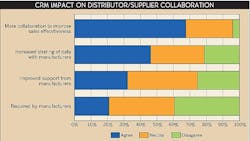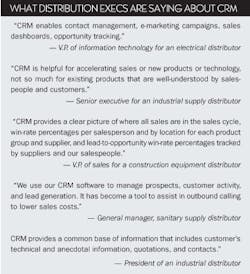CRM (customer relationship management) has traction with distributors because it fills a gap — the ability to manage sales organizations with a disciplined process, using data and metrics to guide effort and measure success. The most common applications for CRM in the distribution industry includes dashboards of customer data, integrated contact management and call planning tools, and pipelines for managing opportunities across a sales process appropriate to each distributor’s business objectives.
While researching my new book, I found almost all distributors’ sales processes had a new emphasis on value selling — a shift from transactional activities and personality-driven relationships — to actually helping customers succeed and measuring results using the customer’s own metrics. For electrical wholesalers, this means serving the diverse needs of contractors, OEMs and end-users.
Innovative distributors are applying CRM’s core capabilities to meet unique competitive dynamics and business objectives. More than 60% of distributors have adopted some form of CRM, and the majority of non-users are actively shopping, trialing or launching an initial implementation. This widespread and growing use of CRM was surprising, especially given strongly held perspectives of legacy CRM systems as inflexible, hard-to-implement time wasters hated by salespeople. However, modern CRM tools offer advantages: innovation achieved through a universe of app developers; mobility gained by running on tablets and smart devices; and lowered maintenance costs offered by cloud solutions.
Distributor executives shared many practical uses of CRM, often uniquely important for distributors. These include integrated lead-to-opportunity management, new products and customer education, sales metrics and supplier collaboration, call centers and cost containment and customer needs and history. Check out the sidebar on page 22, “Distribution Execs Sound Off on CRM” to read what some distributors think about CRM.
Experienced CRM users told us that successfully implementing CRM takes much more time than expected. Salespeople are resistant to change and worry that CRM will help managers micromanage their performance. Integration with ERP is necessary to share customer data, but it’s especially hard when information is shared in both directions. Training should begin at launch and continue as long as needed to encourage use and drive compliance. And if implementing CRM is part of a strategic shift towards proactive business development or value-selling, the existing sales culture and capabilities can be a drag on change. Said one distributor owner, “We found out that the salespeople we have are not always the salespeople we need. It took time to overhaul our sales force.”
Ultimately, CRM is gaining traction because distributors must find ways to strengthen and automate their sales processes in response to increasingly competitive market conditions. Several key findings emerged during our research.
CRM can improve profitability. Some examples of how CRM does this include accelerating opportunities through the sales pipeline; increasing visibility to price and margin pressure in key accounts; proactive response to year-over-year variations in product purchases; and tracking customer calls associated with marketing programs or new products.
Implementing CRM without a plan is a formula for failure. As one distribution company owner explained, “Strategy comes first. Figure out where to target growth. Use CRM to give salespeople customer data for a compelling case and to get them out of the buyer’s office and in front of decision-makers.”
CRM is fast becoming a standard practice. “Our new salespeople expect to use electronic tools on the job,” said one wholesaler. “They grew up with games and social media. As we proved that CRM can improve performance, we made CRM mandatory. It became a condition of employment.”
CRM improves sales coaching. CRM provides actual customer data for sales managers to use when coaching salespeople. “Our managers used to tell salespeople, ‘Just do it the way I did it,’ said one distributor. “Now, we require every coaching interaction to include review of real-time results and real-world customer information.”
Start small, then grow. Salespeople will resist CRM because they fear management oversight and avoid entering contact information and call reports. Successful implementations focus on the situations most likely to help salespeople.
CRM can be transformational. One distribution executive said CRM helps salespeople become “opportunity managers.” Too many salespeople focus on responding to customer requests and plan customer calls as a milk run. They see customers without a plan for each meeting, tailored to each customer’s history and business needs.
Data-Driven Collaboration
“Serving customers isn’t just the responsibility of salespeople,” added the president of an industrial distributor. “Everyone in our business contributes. We are using CRM as the primary portal for everyone to access customer data, and as we roll it out, we are emphasizing the role that each function and individual plays in driving sales results.”
In all industries, a trend exists for high-performing sales organizations to manage by the numbers and leverage analytics for improved results and customer satisfaction. Distributors seeking improved profits and sales through CRM must involve marketing, customer service, operations and finance from the beginning. Digging deeper, we found several focus areas for leveraging data and collaboration across the entire distributor organization.
Account profitability. Many distributors are segmenting customers on twin dimensions of valued services and account profitability so they can deliver the right support at the right customers — and earn an attractive margin in return.
Marketing campaign effectiveness. One distributor executive paraphrased a popular axiom by management guru Peter Drucker. “We find that ‘what gets measured gets managed, and what gets managed gets results,’” he said. “We use this philosophy to break down barriers between sales and marketing.”
Salesperson performance. By definition, not every salesperson can be a top performer — but that doesn’t mean they shouldn’t try. If a distributor can improve middle-performing salespeople from 60% of top performer results to 75%, overall organic growth of by 15% to 20% follows.
Customer trouble tickets. Salespeople are often blind to complaints registered with the customer service department and fail to incorporate resolutions into the overall value created for accounts. CRM improves visibility and can promote teaming for better outcomes.
High-potential/high-risk opportunities. One distributor customized its sales pipelines to track opportunities with customers that were designated as high potential or at risk. CRM enabled improved visibility, enabling management to proactively offer relationship support, service level commitments and other values beyond price-only negotiations.
Coordinating sales efforts with suppliers. We also found that in some distribution industries commercial teams often trip over each other at key accounts and in local territories, delivering competing messages. CRM can improve collaboration between manufacturer and distributors. However, examples of CRM as a tool for improving collaboration between manufacturers and distributors are hard to come by. One industrial manufacturer is encouraging its distributors to adopt a common CRM tool across all markets, including global regions. The long-term goal is to better allocate resources and improve returns on sales and marketing investments, although progress is lagging as distributors struggle with the difficulties of CRM implementation and earning a return on investment.
Some distributors are using CRM to generate pipeline reports and sharing them with manufacturers, albeit with mixed results. As one distributor explained, “We share CRM data with our manufacturer’s channel managers, but they don’t have the freedom to take action. They are constrained by policies and perceptions about legal safe zones. Leaders need to get involved, but are generally skeptical about initiatives that begin with distributors.”
Still, if the potential for gains is real, CRM will eventually help drive collaboration as it becomes a standard practice across the value chain. One distributor is optimistic and found practical, immediate gains simply by comparing relationships in key accounts with favored suppliers. “We don’t know the senior management at our key account customers well enough. They might know that they do a lot of business with us, but we don’t have strong relationships with them.”
By offering to work together to improve product and supply chain deliverables, customers pay attention and open their doors. For this distributor, CRM helped build new customer relationships, and coordinated sales efforts led to new business.
Mark Dancer is the founder and president of Channelvation Inc. and author of Getting the Most Out of CRM: Best Practices for Distributors, available from the National Association of Wholesaler-Distributors (NAW) Institute for Distribution Excellence at www.naw.org/crmfordist. While researching this book he gathered insights from hundreds of distributor executives, including many electrical distributors. Dancer can be reached directly at [email protected].
About the Author
Mark Dancer
Founder and president
Mark Dancer is the founder and president of Channelvation Inc. and author of Getting the Most Out of CRM: Best Practices for Distributors, available from the National Association of Wholesaler-Distributors (NAW) Institute for Distribution Excellence at www.naw.org/crmfordist. While researching this book he gathered insights from hundreds of distributor executives, including many electrical distributors. Dancer can be reached directly at [email protected].

